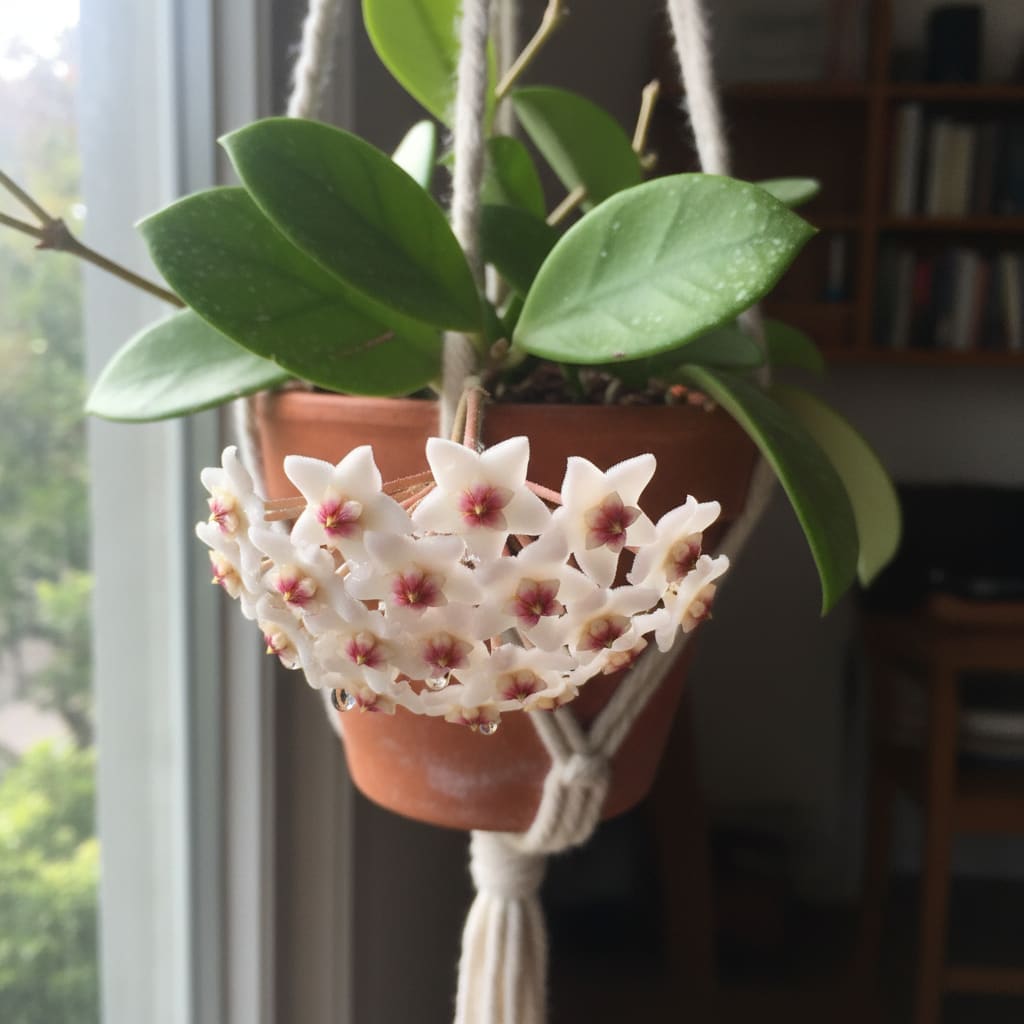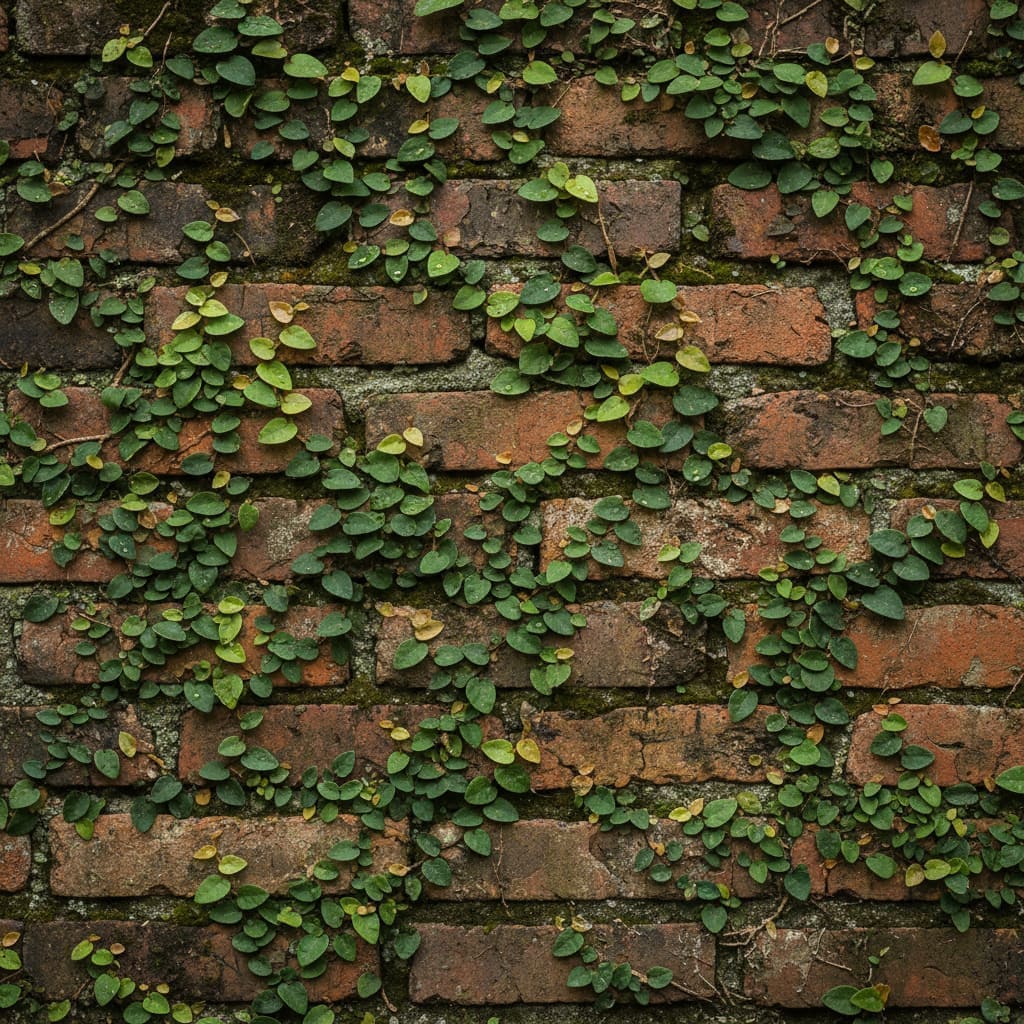Hoya carnosa Care & Growing Guide
Overview
Hoya carnosa, commonly known as the wax plant or porcelain flower, is a long-lived, vining houseplant prized for its thick, glossy leaves and clusters of fragrant, star-shaped blooms. Native to East Asia, this species is an epiphytic climber in the wild, often found twining through trees in warm, humid forests. Indoors, it’s valued for both its ornamental foliage and its unique flowers, which can produce nectar with a sweet, chocolate-like scent.
With proper care, Hoya carnosa can thrive for decades, rewarding patient growers with spectacular blooms and lush growth.
Identification & Growth Habit
Hoya carnosa is a trailing or climbing evergreen perennial. Its leaves are thick, waxy, and oval-shaped, typically dark green, though variegated cultivars exist. Mature plants produce umbels of small, five-pointed flowers with a porcelain-like texture.
- Growth form: Vining, can be trained to climb or allowed to trail.
- Leaf texture: Thick and leathery, with a glossy finish.
- Flower clusters: Spherical umbels, often pink or white with a contrasting center.
Light & Placement
Hoya carnosa thrives in bright, indirect light. Place it near an east- or west-facing window where it receives filtered sunlight. Direct midday sun can scorch the leaves, while too little light may prevent flowering.
- Ideal light: Bright, indirect light for at least 6 hours daily.
- Flowering tip: Ample light is essential to trigger blooms.
Watering & Humidity
Allow the top inch (2–3 cm) of soil to dry before watering. Overwatering is a common cause of root rot, so ensure your pot has drainage holes. Reduce watering frequency in winter when growth slows.
- Humidity: Prefers moderate to high humidity (50–70%).
- Humidity boost: Use a pebble tray or humidifier in dry indoor climates.
Soil & Repotting
Use a well-draining potting mix suitable for epiphytes. A blend of peat moss, perlite, and orchid bark provides both aeration and moisture retention. Repot only when root-bound, typically every 2–3 years, as Hoya carnosa prefers slightly snug conditions.
Fertilizing
Feed monthly during the active growing season (spring and summer) with a balanced liquid fertilizer diluted to half strength. Reduce feeding in fall and winter when growth slows.
Pruning & Training
Prune to control size, remove damaged leaves, or encourage branching. Avoid cutting the long spurs (peduncles) where flowers form, as they can rebloom year after year.
- Training: Use a trellis, hoop, or moss pole for vertical growth, or let vines cascade from a hanging basket.
- Tip: Gentle tying or clipping helps guide vines without damaging stems.
Propagation
Hoya carnosa is easy to propagate from stem cuttings. Follow these steps:
- Choose a healthy stem with at least 2–3 leaves and a visible node.
- Cut just below the node using sterile scissors or pruners.
- Remove the leaf closest to the cut end.
- Place the cutting in water or in moist, well-draining potting mix.
- Keep in bright, indirect light and maintain moderate humidity.
- Roots typically develop in 2–6 weeks; transplant once roots are 2–3 inches long.
Common Problems
Pests
- Mealybugs: White, cottony clusters on leaves and stems. Remove with a cotton swab dipped in rubbing alcohol and treat with insecticidal soap.
- Spider mites: Fine webbing and stippled leaves. Increase humidity and use miticides if infestation persists.
- Scale insects: Brown, shell-like bumps. Scrape off gently and apply horticultural oil.
Diseases
- Root rot: Caused by overwatering. Remove affected roots and repot in fresh, well-draining soil.
- Leaf spot: Fungal or bacterial; remove affected leaves and improve air circulation.
Toxicity & Pet Safety
Hoya carnosa is considered toxic if ingested by pets or humans. Keep out of reach of cats, dogs, and small children, and seek veterinary advice if ingestion occurs.
Styling & Decor Tips
- Display in a hanging basket to showcase trailing vines.
- Train on a decorative trellis for a vertical accent.
- Pair with minimalist pots to highlight the plant’s glossy foliage and intricate blooms.
Varieties & Cultivars
Popular cultivars include:
- Hoya carnosa ‘Krimson Queen’: Variegated leaves with creamy-white margins.
- Hoya carnosa ‘Krimson Princess’: Variegation concentrated in the leaf centers.
- Hoya carnosa ‘Compacta’: Also called Hindu Rope, with tightly curled leaves along the vine.
Buying Tips & Maturity
When purchasing, look for healthy, pest-free foliage and firm, unblemished leaves. Avoid plants with yellowing or mushy stems. Mature plants are more likely to flower, but even young plants can thrive with proper care.
Seasonal Care
- Spring/Summer: Active growth; water regularly, fertilize monthly, and maintain bright light.
- Fall/Winter: Growth slows; reduce watering and feeding, but continue to provide bright light.
- Blooming season: Often late spring to summer; avoid moving the plant when buds form.
FAQ
- How often will my Hoya carnosa flower? With sufficient light and maturity, it may bloom annually, often in late spring or summer.
- Can I grow Hoya carnosa outdoors? In frost-free climates, yes—place in bright, indirect light and protect from harsh sun.
- Why are my Hoya’s leaves yellowing? Common causes include overwatering, poor drainage, or insufficient light.
- Should I remove old flower spurs? No; they can rebloom in future seasons.
- Is Hoya carnosa suitable for beginners? Yes, it’s relatively low-maintenance and forgiving of occasional care lapses.
Sources: Wikipedia, The Spruce
Troubleshooting Growth Issues
- No blooms despite healthy foliage: Increase light intensity and ensure the plant is slightly root-bound; avoid excessive nitrogen fertilizer which can favor leaf growth over flowers.
- Wrinkled leaves: Often a sign of underwatering or prolonged drought; check soil moisture and adjust watering schedule.
- Leggy vines: Caused by insufficient light; move closer to a bright window or supplement with grow lights.
Advanced Pruning & Training Techniques
For experienced growers, selective tip pruning can encourage multiple new shoots from a single vine, creating a fuller plant. Espalier training against a decorative frame can showcase both foliage and blooms in a vertical display. Regularly rotate the plant to promote even growth and prevent leaning toward the light source.
Companion Plant Suggestions
- Philodendron hederaceum: Similar light and watering needs; contrasting leaf shape adds visual interest.
- Orchid species: Share humidity requirements and can complement Hoya’s flowering period.
- Pepperomia obtusifolia: Compact growth habit pairs well with trailing Hoya vines.
Seasonal Care Calendar
| Season | Tasks |
|---|---|
| Early Spring | Resume fertilizing, inspect for winter pest damage, repot if root-bound. |
| Late Spring–Summer | Maintain consistent watering, provide support for new vines, monitor for blooms. |
| Autumn | Reduce feeding, prune lightly to shape, check indoor humidity levels. |
| Winter | Minimize watering, keep away from cold drafts, maximize available light. |
Do & Don't List
- Do: Use clean, sharp tools for pruning to prevent disease spread.
- Do: Allow soil to partially dry between waterings.
- Don't: Remove flower spurs after blooming.
- Don't: Place directly in strong midday sun without acclimation.






